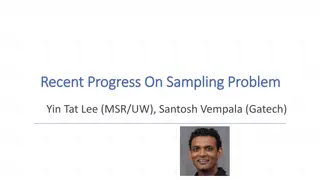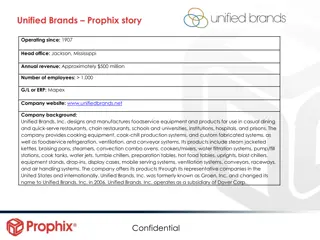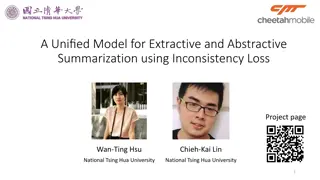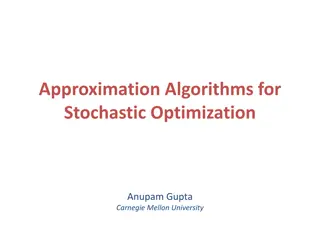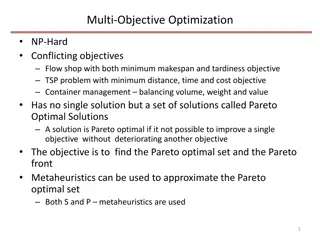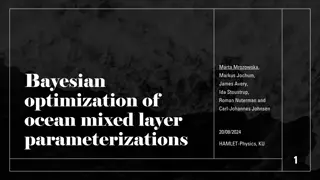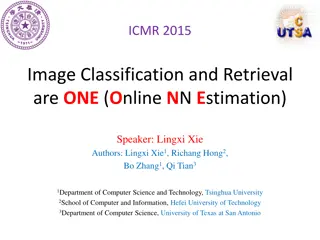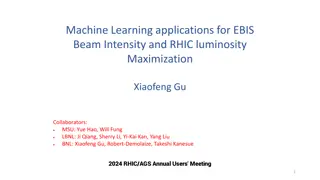
Unified Approach for Modeling and Optimization of Energy, Makespan, and Reliability
Scientific workflows on large-scale computing infrastructures require efficient optimization techniques to manage computations effectively. This research focuses on developing a unified approach for modeling energy consumption, makespan, and reliability to address the complexities of heterogeneous infrastructure conditions. The study aims to validate the energy consumption model, explore multi-objective optimization strategies, and enhance understanding of resource utilization in green computing for scientific workflows.
Download Presentation

Please find below an Image/Link to download the presentation.
The content on the website is provided AS IS for your information and personal use only. It may not be sold, licensed, or shared on other websites without obtaining consent from the author. If you encounter any issues during the download, it is possible that the publisher has removed the file from their server.
You are allowed to download the files provided on this website for personal or commercial use, subject to the condition that they are used lawfully. All files are the property of their respective owners.
The content on the website is provided AS IS for your information and personal use only. It may not be sold, licensed, or shared on other websites without obtaining consent from the author.
E N D
Presentation Transcript
A Unified Approach for Modeling and Optimization of Energy, Makespan and Reliability for Scientific Workflows on Large-Scale Computing Infrastructures Rafael Ferreira da Silva1, Thomas Fahringer2, Juan J. Durillo2, Ewa Deelman1 Workshop on Modeling & Simulation of Systems and Applications August 13-14, 2014, University of Washington, Seattle, Washington 1University of Southern California, Information Sciences Institute, Marina Del Rey, CA, USA 2University of Innsbruck, Technikerstrasse 21a, Innsbruck, Austria
Introduction Scientific workflows are often used to manage large-scale computations on HPC and HTC platforms Several studies have been conducted to optimize workflow scheduling However, most existing optimization techniques are limited to single or two objectives Research in green computing often address cooling and energy usage reduction in large data-centers There are few studies on how resources are used by applications Green computing in scientific workflows Studies are limited to the measurement of energy usage according to resource utilization The energy consumption model is simplistic (e.g., homogeneous execution nodes) 2
Research Goals Development of an energy consumption model to address real large-scale infrastructure conditions e.g., heterogeneity, resource availability, external loads Validation of the model in a fully instrumented platform able to measure the actual temperature and energy consumed by computing, networking, and storage systems Development of a multi-objective optimization approach to explore workflow execution tradeoffs 3
Application Model: Scientific Workflows Directed Acyclic Graph (DAG) Nodes denote tasks Edges denote task dependencies Tasks Command-line programs that read one or more input files and produce one or more output files Compute-intensive or data-intensive Data dependencies Result of output files from one program becoming input files for another program 4
System Model: Distributed Infrastructure Infrastructure as a Service (IaaS) Data and task computations are stored/performed in the infrastructure Distributed Infrastructure 1: Application setup: provision of a set of parameters and input files uploading Host 1 VM Communication Network 2 2: Workflow task scheduling VM 1 Submit Host 3: Output data is stored on the storage server 3 H S 4 VM 4: Output data required by the user is downloaded from the storage server 2 Host 2 VM 5
Runtime and Reliability Models At Workflow Level (Our Expertise) Collect and summarize performance metrics for workflow applications e.g., process I/O, runtime, memory usage, CPU utilization Profile data is used to build distributions of workflow applications At Infrastructure Level (Looking for a Partner) Collect temperature and energy consumption from execution nodes, storage servers, and network systems Requires a fully instrumented platform 6
Research Dimensions Goal: Multi-objective optimization of energy consumption, makespan, and reliability for scientific workflows Monitoring Workflow profile data has been collected as part of the DOE dV/dt project (ER26110) Temperature and energy consumption monitoring requires access to a fully instrumented infrastructure Multi-objective optimization process 7
Research Dimensions Multi-Objective Optimization The improvement of one optimization criteria may imply in the deterioration of another criteria Development of heuristics to reduce the large-search space of workflow executions Modeling (Dynamic Optimization) Models will be constantly updated based on the profiling data collected during the workflow execution Workflow Execution Conducted with the Pegasus WMS (OCI SI2-SSI #1148515) 8
Discussions Major Contribution Multi-objective optimization of energy consumption, makespan, and reliability for scientific workflows on large-scale computing infrastructures Gaps in Current Research There is no energy-aware profiling of scientific workflow applications Research is focused on the optimization of a single or two objectives Strong assumptions are made (e.g., homogeneous environments) Synergistic Projects dV/dT: Accelerating the Rate of Progress Towards Extreme Scale Collaborative Science (DOE ER26110) Pegasus WMS (OCI SI2-SSI #1148515) DOE Sustained Performance, Energy and Resilience (SUPER) project 9
A Unified Approach for Modeling and Optimization of Energy, Makespan and Reliability for Scientific Workflows on Large-Scale Computing Infrastructures Thank you. rafsilva@isi.edu http://pegasus.isi.edu
Mono-Objective Optimization Single optimization goal to improve workflow executions e.g., makespan, cost, etc. 11
Multi-Objective Optimization The improvement of one optimization criteria may imply in the deterioration of another criteria There is no single solution that is optimal with respect to all objectives Determine the Pareto Front 12











